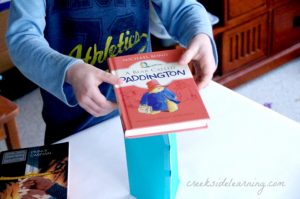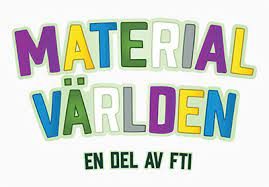Autumn day, the leaves fall in heaps. Now it can be fun to look for leaves of different shapes.
Try leaf hunting, maybe play it like bingo and see who gets a row first…
LeafHunt_Optimized (PDF, 11,2 MB)
Tips downloaded from LearningWithOutdoor
Mötespunkt för pedagoger att dela naturvetenskapliga idéer
Autumn day, the leaves fall in heaps. Now it can be fun to look for leaves of different shapes.
Try leaf hunting, maybe play it like bingo and see who gets a row first…
LeafHunt_Optimized (PDF, 11,2 MB)
Tips downloaded from LearningWithOutdoor
![]() Höstdags, löven faller i driver. Nu kan det var kul att leta löv av olika former.
Höstdags, löven faller i driver. Nu kan det var kul att leta löv av olika former.
Pröva lövjakten, kanske spela det som bingo och se vem som får först en rad…
Lövjakt (PDF, 184kB)
Tips hämtat från LearningWithOutdoor
We are going to test the strength of paper, folded in differently shaped columns, by piling books on top. This is very similar to how columns are used to support buildings and other structures.
 Triangle, square and circle. Which paper is the strongest?
Triangle, square and circle. Which paper is the strongest?
The cylinder can support the most books because it’s walls don’t have any edges. The force of the books cannot become concentrated in a particular area. The load is distributed evenly. In other words, all parts of the cylinder are sharing the load of the books. All parts of the cylinder, therefore, contribute to it’s overall strength until, finally, it collapses.
The square and triangle deform more easily. They shift the weight of the books to their edges and corners, which deforms their walls and leads to a quick collapse. They are unable to carry weight only at their edges.
Have you noticed columns in buildings and other structures, like parking garages? What shape are the columns? Are they on the inside of the building/structure to serve their practical purpose of supporting beams or arches? Or are they exterior columns which lend support but also beauty to the structure?
Early architects in several ancient civilizations used columns in architecture including the ancient Egyptians, Persians, Greeks and Romans.

How many books can you pile on top of each shape? We did this experiment three times and got three different results, although the cylinder always bore the weight of three to four times the amount of books as the square or triangle.
© Copyright 2020 CreeksideLearning.com
Vi ska testa styrkan på papper, vikta i olika formade pelare, genom att stapla böcker ovanpå. Detta liknar mycket hur pelare används för att stödja byggnader och andra strukturer.

Triangel, kvadrat och cirkel. Vilket papper är starkast?
Cylindern kan bära flest böcker eftersom dess väggar inte har några kanter. Böckernas kraft kan inte koncentreras till ett visst område. Lasten fördelas jämnt. Med andra ord delar alla delar av cylindern delar på böckernas belastning. Alla delar av cylindern bidrar därför till dess totala styrka tills den slutligen kollapsar.
Kvadraten och triangeln deformeras lättare. De flyttar böckernas vikt till sina kanter och hörn, vilket deformerar deras väggar och leder till en snabb kollaps. De kan inte bära vikt endast vid sina kanter.
Har du märkt pelare i byggnader och andra strukturer, som parkeringsgarage? Vilken form har pelarna? Är de på insidan av byggnaden/strukturen för att tjäna sitt praktiska syfte att stödja balkar eller valv? Eller är det yttre pelare som ger stöd men också skönhet till strukturen?

Hur många böcker kan du stapla ovanpå varje form? Vi gjorde detta experiment tre gånger och fick tre olika resultat, även om cylindern alltid bar vikten av tre till fyra gånger mängden böcker som kvadraten eller triangeln.
© Upphovsrätt 2020 CreeksideLearning.com
Lär dig om luftmotstånd samtidigt som du tillverkar en fantastisk fallskärm! Designa en som kan falla långsamt till marken innan du sätter den i luften, testa och gör ändringar under tiden. Förhoppningsvis kommer din fallskärm att sjunka långsamt ner till marken och ge din vikt en behaglig landning. När du släpper fallskärmen drar vikten ner strängarna och öppnar upp en stor yta av material som använder luftmotståndet för att sakta ner. Ju större yta, desto större luftmotstånd och desto långsammare faller fallskärmen.
Genom att skära ett litet hål i mitten av fallskärmen kan luften sakta passera genom den i stället för att strömma ut över ena sidan.
bör hjälpa fallskärmen att falla rakare.
Kom ihåg att du vill att den ska falla så långsamt som möjligt.
Tänk på det! Fungerar större fallskärmar bättre? Hur skulle du ändra konstruktionen för att kunna bära en tyngre eller lättare vikt?
Tipset är hämtat från www.projectexploration.org
Learn about air resistance while making an awesome parachute! Design one that can fall slowly to the ground before putting it to the
test, making modifications as you go. Hopefully your parachute will descend slowly to the ground, giving your weight a comfortable
landing. When you release the parachute, the weight pulls down on the strings and opens up a large surface area of material that
uses air resistance to slow it down. The larger the surface area, the more air resistance, and the slower the parachute will drop.
Cutting a small hole in the middle of the parachute will allow air to slowly pass through it rather than spilling out over one side, this
should help the parachute fall straighter.
Think About It! Do bigger parachutes work better? How would you modify the design to carry a heavier or lighter weight?
This experiment is found at www.projectexploration.org
Du kan göra varje ögonblick till ett matematiskt ögonblick genom att använda ”Matematikprat” I filen nedan hittar du matematiska ord och fraser, ordnade efter matematiska begrepp, som du kan använda med barn i åldrarna 2-5 år för att hjälpa dem att utveckla sina matematikkunskaper.
![]()
Matematikprat (PDF, 27kB)
Do like this:
I give a thanks to lekolar.fi for the idea.
 Gör så här:
Gör så här:
Ett tack till lekolar för tipset.
Förpackningsinsamlingen i Sverige har en nätsida med material kring sopsortering. Här finns ett spel man kan spela direkt på deras sidor och material att hämta och arbeta med.

Sidan hittas på: https://materialvarlden.se/